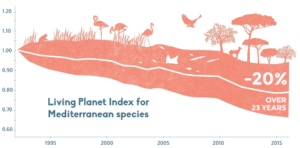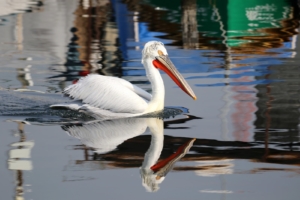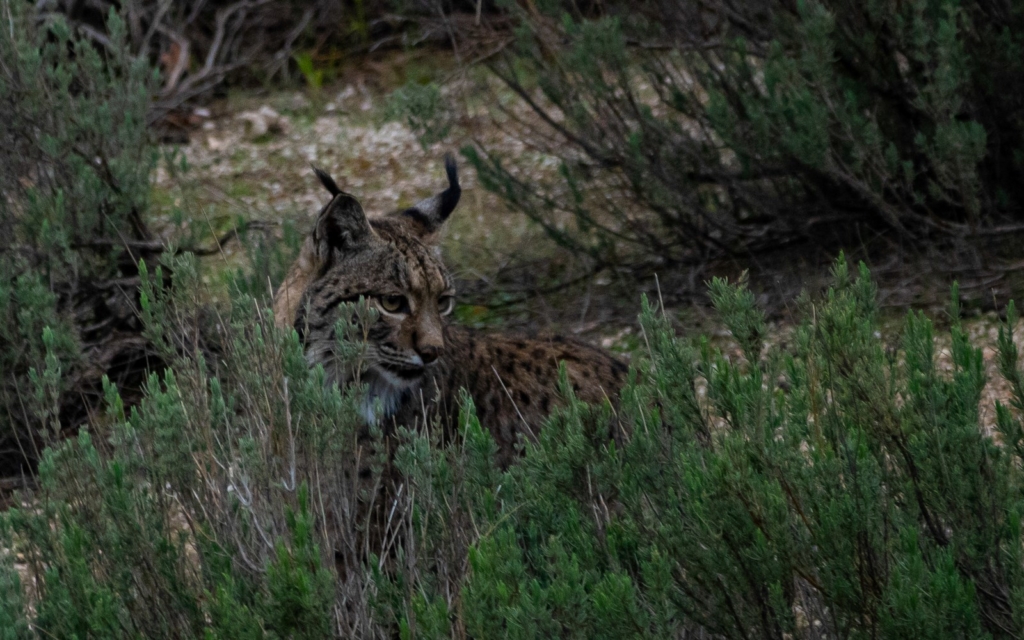PRESS RELEASE
Arles, June 7, 2021

A team of scientists coordinated by the Tour du Valat published today the Living Mediterranean Report, a detailed report on the evolution of Mediterranean biodiversity since 1993.
Living Mediterranean Report, an unequivocal assessment of Mediterranean biodiversity
The natural resources of the Mediterranean Basin have ensured the prosperity of human societies for thousands of years. However, the biodiversity of this exceptional region is seriously threatened.
Climate change is more rapid and the impact of human activities is greater than in other areas, and according to the Living Mediterranean Report, this has resulted in the collapse of its biodiversity.
Nearly 30 years after the Rio Summit commitments, and despite glimmers of hope from numerous conservation efforts, the results presented in the report are alarming:
 between 1993 and 2016, the abundance of vertebrate populations in the Mediterranean Basin declined by 20%, and even by 52% in marine ecosystems (pelagic and coastal), and by 28% in freshwater ecosystems (wetlands and rivers);
between 1993 and 2016, the abundance of vertebrate populations in the Mediterranean Basin declined by 20%, and even by 52% in marine ecosystems (pelagic and coastal), and by 28% in freshwater ecosystems (wetlands and rivers);- Among more than 7,000 plant and animal species evaluated by the IUCN Red List, 20% are in danger of extinction, especially in terrestrial and freshwater ecosystems.
“Most of the species are greatly suffering from the effects of human activity and climate change, the extent of which is expected to increase in the coming decades,” says Thomas Galewski, the study coordinator. “Moreover, a significant proportion of species are endemic to the Mediterranean Basin, and live in restricted distribution areas, making them even more vulnerable.”
A new source of data on Mediterranean biodiversity
Thanks to the meticulous work carried out by the research team, the Living Mediterranean Report presents the most complete synthesis ever carried out on the evolution of the biodiversity of Mediterranean vertebrates.
“Our team of scientists coordinated by Tour du Valat has conducted extensive research on studies published over the last 30 years, gathering abundance monitoring data for more than 80,000 animal populations, in 775 vertebrate species (birds, fish, mammals, reptiles, and amphibians), that is 26% of all species in these taxonomic groups present in the Mediterranean biodiversity hotspot,” says Thomas Galewski. Vertebrate species were targeted because their populations are much better monitored than those of invertebrates (insects, spiders, mollusks, etc.) or plants. Nevertheless, the red lists of threatened species show that the conservation status of the latter is also poor in the Mediterranean Basin.
The volume of data collected makes it possible to calculate the index of abundance representative of biodiversity in the region and to follow its evolution since the Convention on Biological Diversity entered into force in 1993 (see chart [1]).
The causes of the collapse of Mediterranean biodiversity are widely known
Among the reasons for this collapse are overfishing (including bycatch), the large number of dams on rivers, the excessive withdrawal of water resources, and the intensification of agricultural practices, which also leads to the disappearance of emblematic cultural landscapes in the region, such as traditional terrace crops or dehesas[1] [2], rich in biodiversity.
Reason for Hope

In spite of an obvious general decline in Mediterranean biodiversity, conservation actions have had an encouraging impact through the control of hunting and fishing, protection of the habitats of the rarest species, control of sources of pollution, and even increasing species populations through reintroductions. These measures and initiatives have made it possible to save a large number of species from extinction, or even to make them flourish again. Such is the case for the Alpine Ibex, the Black Vulture, the Dalmatian Pelican, and the Loggerhead Turtle.
.Nature is able to regenerate quickly if it is relieved of the pressures on it early enough. “But for biodiversity conservation actions to be more effective in halting biodiversity loss, governments must urgently adopt more ambitious measures that address the root causes of species decline,” says Thomas Galewski. “This includes more inclusive governance and socio-economic models that are consistent with our environmental goals.”
Focus on… recovering species |
|---|
|
|

Biodiversity: a major provider of solutions to global change
Protecting ecosystems that are still in good condition and restoring those that have been degraded by humans allow us to develop countless “Nature-based Solutions” to face current and future challenges, particularly those related to climate change. Wetlands, for example, are home to remarkable biodiversity and play an irreplaceable role as “climate buffers,” absorbing large volumes of water during floods and giving back this essential resource in times of drought. They are also remarkable buffers on the coasts confronted with the rise in sea level, which is now 3 mm per year on average.
The Living Mediterranean Report can be downloaded here [3].
It was produced with support from the French Ministry of Ecological Transition, the TotalEnergies Foundation, and the MAVA Foundation, in partnership with the Centre for Mediterranean Cooperation of the International Union for Conservation of Nature (IUCN), the World Wide Fund for Nature (WWF), the Mediterranean Marine Protected Areas Network (MedPAN), the Mediterranean Wetlands Initiative (MedWet), the Centre for Applied Ecology of the University of Lisbon, and the Zoological Society of London.
Press contact: Thomas Galewski [4], coordinator of the Living Mediterranean Report – [email protected] [5] – +33 (0)6 59 51 49 48
[1] Dehesas: an environment formerly very common in the south of Spain and Portugal. These are extensive pastures where the trees have not been cut. The cattle maintain a very sparse undergrowth while taking advantage of the shade that allows humans to exploit the trees and wild plants. These ecosystems are extremely rich in biodiversity including countless flower and bird species.